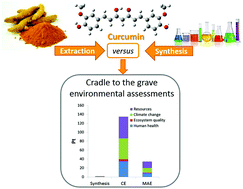Green Chem., 2016, 18,1807-1818
DOI: 10.1039/C6GC00090H, Paper
DOI: 10.1039/C6GC00090H, Paper
Elisabetta Zerazion, Roberto Rosa, Erika Ferrari, Paolo Veronesi, Cristina Leonelli, Monica Saladini, Anna Maria Ferrari
LCA of the synthesis of curcumin and its direct conventional and microwave assisted extractions fromCurcuma longa L. were compared.
LCA of the synthesis of curcumin and its direct conventional and microwave assisted extractions fromCurcuma longa L. were compared.
Phytochemical compounds or their synthetic counterparts? A detailed comparison of the quantitative environmental assessment for the synthesis and extraction of curcumin
Phytochemical compounds or their synthetic counterparts? A detailed comparison of the quantitative environmental assessment for the synthesis and extraction of curcumin
*Corresponding authors
aDipartimento di Scienze e Metodi dell’Ingegneria, Università degli Studi di Modena e Reggio Emilia, via Amendola 2, 42100 Reggio Emilia, Italy
bDipartimento di Ingegneria “Enzo Ferrari”, Università degli Studi di Modena e Reggio Emilia, via Pietro Vivarelli 10, 41125 Modena, Italy
E-mail: roberto.rosa@unimore.it
Fax: +390592056243
Tel: +390592056224
E-mail: roberto.rosa@unimore.it
Fax: +390592056243
Tel: +390592056224
c
Dipartimento di Scienze Chimiche e Geologiche, Università degli Studi di Modena e Reggio Emilia, via Campi 103, 41125 Modena, Italy
Green Chem., 2016,18, 1807-1818
DOI: 10.1039/C6GC00090H
Natural compounds represent an extremely wide category to be exploited, in order to develop new pharmaceutical strategies. In this framework, the number of in vitro, in vivo and clinical trials investigating the therapeutic potential of curcumin is exponentially increasing, due to its antioxidant, anti-inflammatory and anticancer properties. The possibility to obtain this molecule by both chemical synthesis and extraction from natural sources makes the environmental assessments of these alternative production processes of paramount importance from a green chemistry perspective, with the aim, for both industries and academia, to pursue a more sustainable development. The present work reports detailed and quantitative environmental assessments of three different curcumin production strategies: synthesis, conventional Soxhlet-based extraction (CE) and microwave-assisted extraction (MAE). The chemical synthesis of curcumin, as recently optimized by the authors, has been firstly evaluated by using the EATOS software followed by a complete “cradle to the grave” study, realized by applying the Life Cycle Assessment (LCA) methodology. The life cycles of CE and MAE were then similarly assessed, considering also the cultivation of Curcuma longa L., the production of the dried rhizomes as well as their commercialization, in order to firstly investigate the widely claimed green character of MAE with respect to more conventional extraction procedures. Secondly, the results related to the two different extraction strategies were compared to those obtained by the chemical synthesis of curcumin, with the aim to determine its greenest preparation procedure among those investigated. This work represents the first example of an environmental assessment comparison between different production strategies of curcumin, thus smoothing the way towards the highly desirable establishment of environmentally friendly rankings, comprising all the existing alternatives to the chemical synthesis of a target chemical compound.
/////Phytochemical compounds, synthesis, extraction, curcumin












